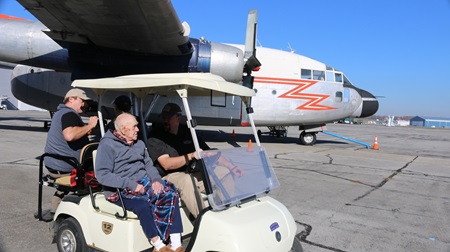A birthday flight made for memories
Former Fairchild Aircraft factory worker John Young's 100th birthday was approaching, and he had one wish: to fly.
Young spent more than 20 years on the assembly line in the Fairchild Aircraft factory in Hagerstown, Maryland. “I was laid off about three times,” Young said. “But I still went back because I loved airplanes.”
“It was an opportunity we had to take,” Rosenthal said. “Charlie and I are both civic minded in doing good deeds.”
The two pilots planned to fly the club’s Cessna 182 to Hagerstown and suggested the birthday celebration be held in the fall to get ahead of winter weather.
The Hagerstown Aviation Museum now occupies the historic 1943 Flight Test Hangar at the former Fairchild plant. A call to Austin Colby, a museum board member, and a full-fledged party plan took shape, including a factory tour and a lunch of hamburgers, hot dogs, baked beans, and ambrosia—the retired airplane builder's favorites—provided by Experimental Aircraft Association Chapter 36.
Young's November 3 visit to the former factory marked the first time in decades he had been in the cavernous buildings, where aircraft building ceased when the plant closed in the early 1980s.
A vision impairment dating to childhood prevented Young from serving in World War II, so he began working in factories. His first job was for Victor Products making refrigeration units, later joining Fairchild sometime in the mid- to late-1940s when the Fairchild C–82 Packet cargo airplane was being produced.
Only 223 of the little-known twin-engine, twin-boom airplanes were built. It’s notable because it was the first cargo airplane to feature rear clamshell doors that made loading vehicles, equipment, or troops easier and more efficient. Its successor, the Fairchild C–119 Flying Boxcar, was used extensively during the wars in Korea and Vietnam. Between 1949 and 1955, more than 1,100 rolled out of the factory in Hagerstown.
Young did general assembly work, including riveting and building C–119 wings. “I also worked on the tail a little bit, and alternated on jobs,” he said. “The job was wonderful.”

Touring the empty former factory on a golf cart, he said he didn’t realize how high the ceilings were. “God they had marvelous crane work. It was a beautiful place to work. I enjoyed my work so much. I miss it.”
The tour included a look at the museum's collection, including the last flyable C–82, a C–119, and a C–123 Provider parked outside the historic “Dome Hangar" built in 1943—completely out of wood because all the steel was being used to support the war effort. In another massive hangar, the museum has a 1919 Bellanca CE, the first aircraft built in Hagerstown. The collection also includes three Fairchild PT–19s used to train pilots in World War II and a PT–26, which is a PT–19 variant with a canopy used by the Royal Canadian Air Force. There hangar also houses a military ambulance and a Sherman tank.

Before the factory tour, Rosenthal took Young; Young's son, Rick; and Harman for a flight. Rosenthal is a CFI, so the guest of honor flew in the left seat. (It took a team effort to get him settled in.)
Rosenthal fired up the engine and taxied from the museum ramp to Runway 27 at Hagerstown Regional Airport/Richard A. Henson Field. He advanced the throttle and eased the airplane gently into a crisp, clear fall sky for a 30-minute flight.
“We flew by the Fairchild plant so John could see that,” Rosenthal said. “I think everyone on board enjoyed it and it was a real thrill for him.”
Young confirmed he had thoroughly enjoyed the entire experience: “Did I? You did great. That plane ride was worth it. And bringing my son along with me, Ricky. The ride was marvelous.”
More gifts followed, including an honorary AOPA membership. Young had flown years ago with friends, but this was Harman's first flight in a general aviation aircraft. Seeing the factory from the air made an impression: “It was a lot bigger than I thought. It’s kind of overwhelming when you take it all in,” she said. “And then you think about all the people that worked there and what they did. It’s awesome.”

Her favorite part of the day was when they were in the air “hearing John say how nice it was and seeing him smile.”
“The best thing for me was seeing John after the flight and hearing him talk about how much he enjoyed it.”
This was also a special mission for Mayer: “The last time I saw my grandfather was on a flight like this,” he said. “I flew up to New Hampshire and flew around with him. He passed away a few months later.”
Mayer knows firsthand the difference good staff and nurses can make when they go above and beyond their regular duties, having family of his own in such care.
“Charlie and I are just happy that we were able to make this happen,” Rosenthal said. “We just hope that when we’re turning 100, someone will do this for us.”
Harman said the plan succeeded beyond her ambition.
“It turned into something a lot bigger than I had anticipated,” she said. “I’m just very happy for John and I’m very thankful for everyone for putting it all together.”
“This is why I go into nursing,” she added. “It’s been rough the last almost three years because of Covid, but these are the moments that make it worth it.”
The memories of that crisp autumn day at the former Fairchild factory will be a blessing to those left behind after Young died on November 29 at the age of 99.




